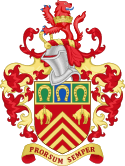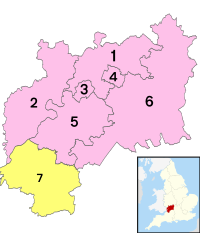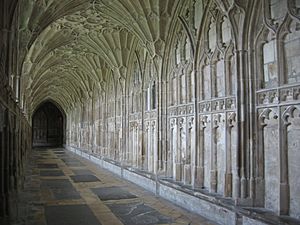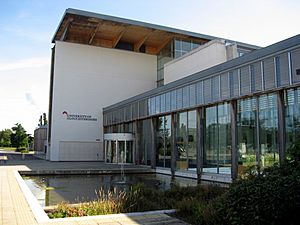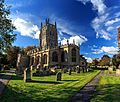Gloucestershire facts for kids
Quick facts for kids
Gloucestershire
|
|||||||||||||||||||||||||||||||||||||||||||||||||||||||||||
|---|---|---|---|---|---|---|---|---|---|---|---|---|---|---|---|---|---|---|---|---|---|---|---|---|---|---|---|---|---|---|---|---|---|---|---|---|---|---|---|---|---|---|---|---|---|---|---|---|---|---|---|---|---|---|---|---|---|---|---|
|
|||||||||||||||||||||||||||||||||||||||||||||||||||||||||||
| Motto(s):
Prorsum semper
("Ever forward") |
|||||||||||||||||||||||||||||||||||||||||||||||||||||||||||
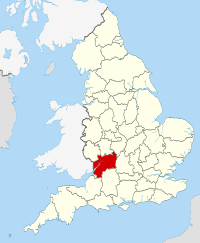 |
|||||||||||||||||||||||||||||||||||||||||||||||||||||||||||
| Sovereign state | United Kingdom | ||||||||||||||||||||||||||||||||||||||||||||||||||||||||||
| Constituent country | England | ||||||||||||||||||||||||||||||||||||||||||||||||||||||||||
| Region | South West | ||||||||||||||||||||||||||||||||||||||||||||||||||||||||||
| Established | Ancient | ||||||||||||||||||||||||||||||||||||||||||||||||||||||||||
| Time zone | UTC±00:00 (Greenwich Mean Time) | ||||||||||||||||||||||||||||||||||||||||||||||||||||||||||
| • Summer (DST) | UTC+01:00 (British Summer Time) | ||||||||||||||||||||||||||||||||||||||||||||||||||||||||||
| Members of Parliament | List of MPs | ||||||||||||||||||||||||||||||||||||||||||||||||||||||||||
| Police | Gloucestershire Constabulary | ||||||||||||||||||||||||||||||||||||||||||||||||||||||||||
|
|||||||||||||||||||||||||||||||||||||||||||||||||||||||||||
Gloucestershire (often called Glos) is a county in South West England. It is known for its beautiful countryside. You can find parts of the Cotswold Hills here. It also has a flat, fertile valley around the River Severn. The whole Forest of Dean is also in Gloucestershire.
The main town of the county is the city of Gloucester. Other important towns include Cheltenham, Stroud, and Tewkesbury. You can also find Cirencester, Dursley, Cinderford, and Lydney here.
Gloucestershire shares its borders with several other places. To the north-west is Herefordshire. Worcestershire is to the north, and Warwickshire is to the north-east. To the east, you'll find Oxfordshire. Wiltshire is to the south. Bristol and Somerset are to the south-west. Finally, the Welsh county of Monmouthshire is to the west.
The area managed by the Gloucestershire County Council is not exactly the same as the historic county. Some northern parts moved to Warwickshire in 1931. Later, in 1974, some southern parts became part of a new county called Avon. Avon stopped existing in 1996. After that, Bristol and South Gloucestershire became their own separate areas.
Contents
History of Gloucestershire
Gloucestershire is a very old county. It was first mentioned in the Anglo-Saxon Chronicle in the 900s. Areas like Winchcombe and the Forest of Dean were added later, in the late 1000s.
Bristol was once a small town within Gloucestershire. It grew into a busy port city. Because of its growth, Bristol became its own county in 1373. It was separate from both Gloucestershire and Somerset. Later, from 1974 to 1996, Bristol was part of the administrative County of Avon.
When Avon was ended in 1996, the area north of Bristol became South Gloucestershire. This area is now part of the wider ceremonial county of Gloucestershire.
In July 2007, Gloucestershire experienced very heavy flooding. Many residents were affected. The RAF helped rescue over 120 people. This was the largest peacetime rescue operation in the RAF's history. The damage from the floods was estimated to be over £2 billion.
The county quickly recovered from this event. It worked hard to attract tourists to visit its many sites and shops.
Towns and Cities in Gloucestershire
Gloucestershire has one city and 32 towns.
The City of Gloucester
Towns in Gloucestershire
The towns in Gloucestershire are:
There is also a town in Monmouthshire with parts extending into Gloucestershire:
Historic Buildings and Sites
Gloucestershire has many interesting old buildings. These include the grand cathedral in Gloucester. There is also the abbey church in Tewkesbury. The church in Cirencester is also very notable.
The abbey of Hailes near Winchcombe was founded in 1246. Only its foundations remain today. These have been dug up and studied by archaeologists.
Most old market towns have historic parish churches. The churches at Deerhurst and Bishop's Cleeve are special. They have parts that are older than the Norman Conquest. The church in Lechlade is built in the Perpendicular style. The church at Fairford was built around 1500. It is famous for its beautiful stained-glass windows. These windows are thought to be English-made.
Other important buildings include Calcot Barn. This barn is a remaining part of Kingswood Abbey. Thornbury Castle is a Tudor country house. It was built by the Duke of Buckingham. Near Cheltenham is Southam de la Bere, a 15th-century mansion. It is made of timber and stone. This mansion has a tiled floor that came from Hailes Abbey. At Great Badminton, you can find the large mansion of the Beaufort family.
Several royal residences are in Gloucestershire. These include Highgrove House and Gatcombe Park.
An exciting annual event is the "cheese-rolling" at Cooper's Hill. This happens near Brockworth. The Cotswold Games also take place in the county.
Places to Visit
| Key | |
| Owned by the National Trust | |
| Owned by English Heritage | |
| Owned by the Forestry Commission | |
| A Country Park | |
| An Accessible open space | |
| Museum (free) | |
| Museum (charges entry fee) | |
| Heritage railway | |
| Historic House | |
Here are some interesting places to visit in Gloucestershire:
- Badminton House, home of the Dukes of Beaufort
- Berkeley Castle, a strong old castle
- Beverston Castle
- Chavenage House

- Cheltenham Town Football Club
- Clearwell Caves
- Dean Forest Railway

- Dyrham Park

- Edward Jenner's House

- Gloucester Cathedral

- Gloucester Rugby
- Gloucestershire Warwickshire Railway

- Hailes Abbey

- Newark Park

- Owlpen Manor

- Snowshill Manor

- Sudeley Castle, where Queen Catherine Parr is buried. She was King Henry VIII's sixth wife.
- Stanway House

- River Thames

- Rodmarton Manor

- Severn Bore

- Tewkesbury Abbey

- Tewkesbury Medieval Festival
- Tyndale Monument

- Wildfowl and Wetland Trust, Slimbridge
- Westbury Court Garden
- Woodchester Mansion

You can also explore these natural areas in Gloucestershire:
There is also a scenic railway line:
- Gloucester to Newport Line
Gloucestershire in Popular Culture
Gloucestershire has been featured in many books and films. Laurie Lee's Cider With Rosie tells about growing up in rural Gloucestershire. A Child in the Forest by Winifred Foley is another well-known story. Part of Mrs. Craik's novel John Halifax, Gentleman is set in a fictional town based on Amberley.
The county has also been a filming location for movies and TV shows. These include Die Another Day and the Harry Potter films. The BBC TV series Butterflies was also filmed here. The movie Hot Fuzz was set in Gloucestershire. Simon Pegg, who co-wrote and starred in the film, grew up in the area.
The pilot episode for the Doctor Who spin-off, K-9 and Company, was filmed in Gloucestershire. The story takes place in the fictional town of Moreton Harwood.
The fictional town of Leadworth in Doctor Who is also located in Gloucestershire. It is the childhood home of companions Amy Pond, Rory Williams, and River Song.
In the 1970s BBC TV series Survivors, the fictional village of Brimpsfield was the home of Peter and Abby Grant. It had a railway connection to London.
Animals of Gloucestershire
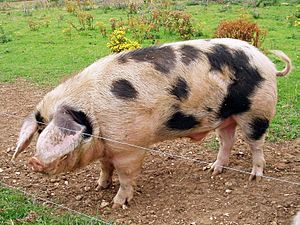
The famous Gloucestershire Old Spots pig breed is named after Gloucestershire. It has a long history in the county. Wild sheep roam freely in the Forest of Dean. The Forest of Dean and the Wye Valley are also home to wild boar.
Gloucester cattle are a rare breed. You can still find them in Gloucestershire. They have a white stripe running down their backs to their tails. These cattle are famous for producing milk. This milk is used to make both Single Gloucester and Double Gloucester cheeses.
Education in Gloucestershire
Secondary Schools
- Further information: List of schools in Gloucestershire
Gloucestershire has many comprehensive schools. There are also seven selective schools. Two are in Stroud: Stroud High School for girls and Marling School for boys. One is in Cheltenham, Pate's Grammar. Four are in Gloucester: Sir Thomas Rich's (boys 11-18, girls 16-18), Denmark Road High School and Ribston Hall for girls, and The Crypt which is mixed.
Most schools in the county have a sixth form. This is where students can continue their studies after age 16.
Higher and Further Education
Gloucestershire has two universities. These are the University of Gloucestershire and the Royal Agricultural University. There are also four colleges for higher and further education. These include Gloucestershire College, Cirencester College, South Gloucestershire and Stroud College, and the Royal Forest of Dean College. Each of these colleges has campuses in different parts of the county.
The University of the West of England also has locations in Gloucestershire. One is Hartpury College, which focuses on animal behavior, agriculture, and sports. Another is a regional center at the Gloucester Docks. This center specializes in nursing courses.
Transport by Rail
Gloucestershire used to have a much larger railway network. There were over 100 stations in the county. Most of these closed during the Beeching cuts in the 1960s.
Today, only 15 stations remain in the county. Most are on the main CrossCountry NE-SW route. Some stations have reopened in recent years. Cam and Dursley railway station opened in 1994. Ashchurch for Tewkesbury opened three years later. Local groups are working to reopen other disused stations. One example is Charfield railway station in South Gloucestershire.
Images for kids
See also
 In Spanish: Gloucestershire para niños
In Spanish: Gloucestershire para niños



